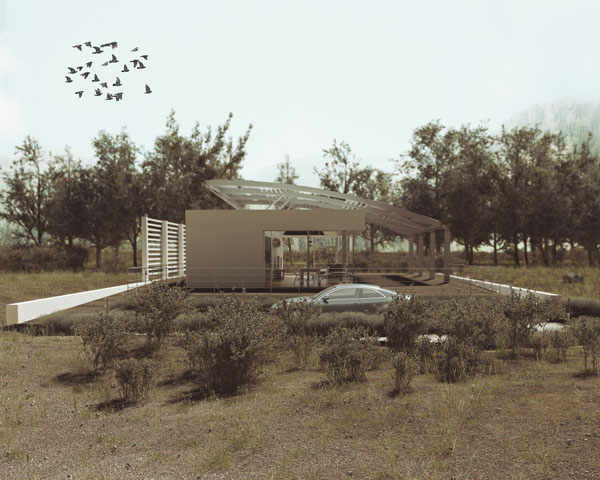Fourteen small, quirky houses appeared on a decommissioned Marine Corps Air Station in Irvine, California last October. The abundance of solar panels, hydroponic gardens, and electric car-charging stations may have given the impression to passersby that a miniature eco-village had popped up almost overnight. But the houses were finalists in the U.S. Department of Energy’s Solar Decathlon—a prestigious competition that invites students from all over the world to develop creative solutions to energy challenges by designing, building, and operating their own solar-powered houses. Despite the variation in their approach to energy infrastructure, many ultimately resembled one another in their markedly industrial, boxy appearance. Which is why one—with a remarkably elegant design, airy feel, and, most striking of all, a Roman-style arch crowning its compact central living quarters—stood out.
It is called STILE House (Sustainable Technologies Integrated in a Learning Experience), and students from the University of West Virginia and the University of Rome Tor Vergata spent two years fine-tuning its integrated approach to energy efficiency, as well as its striking aesthetic design. STILE House, which won the Fan Favorite award, is all about cooperative opposition: between functional Appalachian and classical Roman architecture, between sustainability and comfort, and between compact design and organic communion with the surrounding natural world.

he Roman-inspired arch provides the proper angle for solar panels to generate enough electricity to power the entire house.
Appalachian + Roman
The essential structure of the STILE House pays tribute to the backgrounds of the American and Italian students who designed and built it. The sturdy, rectangular shape of the main living area, complete with sliding barn-style doors, was inspired by the functional architecture of West Virginia, while the elegant arch that supports the solar array references a classic Roman style. STILE team member Todd Funkhouser, a civil engineering student at West Virginia University, explains that this collaboration helped its creators develop as designers and enhanced STILE’s aesthetic value. “It helped us get as much cross-cultural experience as we could, and showed us how European and American design teams can work together,” he says.
Sustainable + Livable
The STILE team needed to navigate the relationship between sustainability and livability. Molly Banfield, also a civil engineering student at WVU, explains that the team wanted to demonstrate that consumers need not approach residential projects with an either/or philosophy. “Sustainability and livability were valued equally,” she says. “We were really trying to show that sustainability is livable.”
This non-binary approach to the house’s design is evident when considering the sustainability impact of its most attractive components: floor-to-ceiling windows which provide ample natural light and also reduce energy consumption through passive solar heating. A living green wall contributes a lively array of flora and reduces the need for residents to consume energy traveling for fresh produce. The Roman-inspired arch, which gives the house its signature façade, also provides the proper angle for solar panels to generate enough electricity to power the entire house.
The house’s openness, especially evident in its combined central living, dining, and kitchen area, creates a layout ideal for entertaining. It also provides the perfect layout for the house’s sophisticated solar chimney to use convection currents and differences in air pressure to cool the combined living areas at the same time.
“A huge cost for houses is heating and cooling, which is where the solar chimney came in,” Banfield says. “The passive cooling system doesn’t use electricity. You can just open your solar chimney and your vents along the floor and let the convection currents throughout the house work their magic.”
The solar chimney works when both the skylight in the center of the main living area and floor vents along the East and West walls of the house are opened. Warm, less-dense air can escape through the skylight, which pulls cool, shaded air in from beneath the house, lowering the temperature and providing fresh air without any energy consumption.
Self-Contained + Connected
Perhaps the greatest triumph of the STILE house is its natural integration with the outside world despite its very sleek, compact design. Banfield explained that this focus on the natural environment was an important aspect of the house’s sustainability goals.
“Connectedness with the outside world is an important part of sustainability, so we wanted the deck not to be a separate space so much as a continuation of your living space,” she explains.
Just outside the main living area is the outdoor deck, which is shaded by the arch. This creates the illusion of an extended indoor living space. It also allows for a very gentle, gradual transition between the built and natural environment, which represents a lifestyle that integrates the built and natural environment seamlessly.
Funkhouser elaborates on this effect. “We used floor-to-ceiling windows to create as little visual distraction as we could,” he says. “We also put the floor at the same level as the decking outside so that your eye didn’t get caught on that transition and could just look right past it and onto the outside.”
The STILE House balances cultural designs, sustainability and livability, and the built and natural environments. This dynamic creativity nods to the future of energy efficiency, which will undoubtedly become an increasingly strong force pushing style forward.

